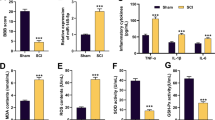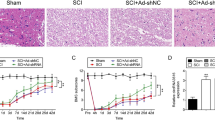Abstract
Spinal cord injury (SCI) is a major cause of paralysis, disability and even death in severe cases. Lithium has neuroprotective effects on SCI, while the underlying mechanisms remain obscure. In the present study, we established a SCI rat model, which subsequently received lithium treatment. Results displayed that lithium treatment improved the locomotor function recovery and reduced apoptosis by increasing anti-apoptotic molecule expression and decreasing pro-apoptotic factor expression in SCI rats. Furthermore, lithium treatment alleviated the inflammatory response by inactivating the nuclear factor-kappa B (NF-κB) pathway and inhibited the expression of lncRNA brain-derived neurotrophic factor antisense (BDNF-AS) in SCI rats. Subsequent researches indicated that miR-9-5p was targeted and regulated by BDNF-AS. Lithium treatment rescued the upregulation of BDNF-AS expression and downregulation of miR-9-5p expression induced by H2O2 in SH-SY5Y cells. BDNF-AS overexpression or miR-9-5p interference attenuated the anti-apoptotic and anti-inflammatory effects of lithium chloride in SH-SY5Y cells that was damaged by H2O2 induction, revealing that lithium might act through the BDNF-AS/miR-9-5p axis. In vivo studies showed that the injection of BDNF-AS adenovirus vector or miR-9-5p inhibitor reversed the effects of lithium on the histologic morphology of spinal cord, motor function, inflammatory reaction and apoptosis in SCI rats, which was consistent with the results of in vitro studies. In conclusion, our data demonstrated that lithium reduced SCI-induced apoptosis and inflammation in rats via the BDNF-AS/miR-9-5p axis.






Similar content being viewed by others
References
Abdanipour A, Moradi F, Fakheri F, Ghorbanlou M, Nejatbakhsh R (2019) The effect of lithium chloride on BDNF, NT3, and their receptor mRNA levels in the spinal contusion rat models. Neurol Res 41:577–583
Bhalala OG, Srikanth M, Kessler JA (2013) The emerging roles of microRNAs in CNS injuries. Nat Rev Neurol 9:328–339
Chen L, Zhao JC (2014) Functional analysis of long noncoding RNAs in development and disease. Adv Exp Med Biol 825:129–158
Cizkova D, Murgoci AN, Cubinkova V, Humenik F, Mojzisova Z, Maloveska M, Cizek M, Fournier I, Salzet M (2020) Spinal cord injury: animal models, imaging tools and the treatment strategies. Neurochem Res 45:134–143
Fang XY, Zhang W, Zhang C, Wong W, Li W, Wu W, Lin J (2016) Lithium accelerates functional motor recovery by improving remyelination of regenerating axons following ventral root avulsion and reimplantation. Neuroscience 329:213–225
Fu R, Tang Y, Ling ZM, Li YQ, Cheng X, Song FH (2014) Lithium enhances survival and regrowth of spinal motoneurons after ventral root avulsion. Bmc Neurosci 15:84–97
Gu C, Zhang Y, Hu Q, Wu J, Ren H, Liu C, Wang G (2017) P7C3 inhibits GSK3β activation to protect dopaminergic neurons against neurotoxin-induced cell death in vitro and in vivo. Cell Death Dis 8:e2858
Hou L, Heilbronner U, Degenhardt F, Adli M, Akiyama K, Akula N, Ardau R, Arias B, Backlund L, Banzato CE (2016) Genetic variants associated with response to lithium treatment in bipolar disorder: a genome-wide association study. The Lancet 387:1085–1093
Huang Q, Yang J, He X, Shi S, Xing S (2018) LncRNA BDNF-AS is associated with the malignant status and regulates cell proliferation and apoptosis in osteosarcoma. Bioscience Rep 38:1–7
Huo K, Sun Y, Li H, Du X, Wang X, Karlsson N, Zhu C, Blomgren K (2012) Lithium reduced neural progenitor apoptosis in the hippocampus and ameliorated functional deficits after irradiation to the immature mouse brain. Mol Cell Neurosci 51:32–42
Kazemi H, Noori Zadeh A, Darabi S, Rajaei F (2018) Lithium prevents cell apoptosis through autophagy induction. Bratisl Med J 119:234–239
Kim Y, Kim J, Ahn M, Shin T (2017) Lithium ameliorates rat spinal cord injury by suppressing glycogen synthase kinase-3beta and activating heme oxygenase-1. Adv Anat Embryol Cel 50:207–213
Krell J, Frampton AE, Jacob J, Pellegrino L, Roca Alonso L, Zeloof D, Alifrangis C, Lewis JS, Jiao LR, Stebbing J (2012) The clinico-pathologic role of microRNAs miR-9 and miR-151-5p in breast cancer metastasis. Mol Diagn Ther 16:167–172
Li B, Ren J, Yang L, Li X, Sun G, Xia M (2018) Lithium inhibits GSK3beta activity via two different signaling pathways in neurons after spinal cord injury. Neurochem Res 43:848–856
Li G, Wu F, Yang H, Deng X, Yuan Y (2017) MiR-9-5p promotes cell growth and metastasis in non-small cell lung cancer through the repression of TGFBR2. Biomed Pharmacother 96:1170–1178
Lin WP, Lin JH, Cai B, Shi JX, Li WJ, Choudhury GR, Wu SQ, Wu JZ, Wu HP, Ke QF (2016) Effect of adenovirus-mediated RNA interference of IL-1beta expression on spinal cord injury in rats. Spinal Cord 54:778–784
Liu W, Wang X, Zheng Y, Shang G, Huang J, Tao J, Chen L (2016) Electroacupuncture inhibits inflammatory injury by targeting the miR-9-mediated NF-kappaB signaling pathway following ischemic stroke. Mol Med Rep 13:1618–1626
Modarresi F, Faghihi MA, Lopez Toledano MA, Fatemi RP, Magistri M, Brothers SP, van der Brug MP, Wahlestedt C (2012) Inhibition of natural antisense transcripts in vivo results in gene-specific transcriptional upregulation. Nat Biotechnol 30:453–459
Pan Y, Zhang Y, Liu W, Huang Y, Shen X, Jing R, Pu J, Wang X, Ju S, Cong H et al (2019) LncRNA H19 overexpression induces bortezomib resistance in multiple myeloma by targeting MCL-1 via miR-29b-3p. Cell Death Dis 10:106
Rong Y, Liu W, Lv C, Wang J, Luo Y, Jiang D, Li L, Zhou Z, Zhou W, Li Q (2019) Neural stem cell small extracellular vesicle-based delivery of 14-3-3t reduces apoptosis and neuroinflammation following traumatic spinal cord injury by enhancing autophagy by targeting Beclin-1. Aging-US 11:7723–7745
Sabirzhanov B, Matyas J, Coll-Miro M, Yu LL, Faden AI, Stoica BA, Wu J (2019) Inhibition of microRNA-711 limits angiopoietin-1 and Akt changes, tissue damage, and motor dysfunction after contusive spinal cord injury in mice. Cell Death Dis 10:839
Shi Z, Pan B, Feng S (2018) The emerging role of long non-coding RNA in spinal cord injury. J Cell Mol Med 22:2055–2061
Shin T, Ahn M, Moon C, Kim S, Sim KB (2013) Alternatively activated macrophages in spinal cord injury and eemission: another mechanism for repair? Mol Neurobiol 47:1011–1019
Song Z, Yang W, Zhou X, Yang L, Zhao D (2017) Lithium alleviates neurotoxic prion peptide-induced synaptic damage and neuronal death partially by the upregulation of nuclear target REST and the restoration of Wnt signaling. Neuropharmacology 123:332–348
Thuret S, Moon LDF, Gage FH (2006) Therapeutic interventions after spinal cord injury. Nat Rev Neurosci 7:628–643
Wang Z, Sun L, Jia K, Wang H, Wang X (2019) miR-9-5p modulates the progression of Parkinson’s disease by targeting SIRT1. Neurosci Lett 701:226–233
Wei N, Xiao L, Xue R, Zhang D, Zhou J, Ren H, Guo S, Xu J (2016) MicroRNA-9 mediates the cell apoptosis by targeting Bcl2l11 in ischemic stroke. Mol Neurobiol 53:6809–6817
Wei N, Zheng K, Xue R, Ma S, Ren H, Huang H, Wang W, Xu J, Chen K (2017) Suppression of microRNA-9-5p rescues learning and memory in chronic cerebral hypoperfusion rats model. Oncotarget 8:107920–107931
Xia P, Gao X, Duan L, Zhang W, Sun YF (2018) Mulberrin (Mul) reduces spinal cord injury (SCI)-induced apoptosis, inflammation and oxidative stress in rats via miroRNA-337 by targeting Nrf-2. Biomed Pharmacother 107:1480–1487
Xu Y, An BY, Xi XB, Li ZW, Li FY (2016) MicroRNA-9 controls apoptosis of neurons by targeting monocyte chemotactic protein-induced protein 1 expression in rat acute spinal cord injury model. Brain Res Bull 121:233–240
Young W (2009) Review of lithium effects on brain and blood. Cell Transplant 18:951–975
Zakeri M, Afshari K, Gharedaghi M, Shahsiah R, Rahimian R, Maleki F, Dehpour A, Javidan A (2014) Lithium protects against spinal cord injury in rats: role of nitric oxide. J Neurol Surg Part A 75:427–433
Zhang D, Wang F, Zhai X, Li XH, He XJ (2018) Lithium promotes recovery of neurological function after spinal cord injury by inducing autophagy. Neural Regen Res 13:2191–2199
Zhang H, Li D, Zhang Y, Li J, Ma S, Zhang J, Xiong Y, Wang W, Li N, Xia L (2018) Knockdown of lncRNA BDNF-AS suppresses neuronal cell apoptosis via downregulating miR-130b-5p target gene PRDM5 in acute spinal cord injury. RNA Biol 15:1071–1080
Zhang Y, Yan L, Cao Y, Kong G, Lin C (2016) Long noncoding RNA BDNF-AS protects local anesthetic induced neurotoxicity in dorsal root ganglion neurons. Biomed Pharmacother 80:207–212
Zheng J, Peng B, Zhang Y, Ai F, Hu X (2019) miR-9 knockdown inhibits hypoxia-induced cardiomyocyte apoptosis by targeting Yap1. Life Sci 219:129–135
Zheng X, Lin C, Li Y, Ye J, Zhou J, Guo P (2016) Long noncoding RNA BDNF-AS regulates ketamine-induced neurotoxicity in neural stem cell derived neurons. Biomed Pharmacother 82:722–728
Zhou F, Guan Y, Chen Y, Zhang C, Yu L, Gao H, Du H, Liu B, Wang X (2013) miRNA-9 expression is upregulated in the spinal cord of G93A-SOD1 transgenic mice. Int J Clin Exp Patho 6:1826–1838
Funding
This work was supported by the National Natural Science Foundation of China (No. 81701223), the Natural Science Foundation in Shaanxi Province (No. 2017JQ8019) and the Fundamental Research Funds for the Central Universities (No. 1191329737).
Author information
Authors and Affiliations
Corresponding author
Ethics declarations
Conflict of interest
The authors declare that they have no conflict of interest.
Ethical approval
All procedures performed in the studies involving animals were approved by the Animal Ethical and Welfare Committee of The Second Affiliated Hospital of Xi'an Jiaotong University (permit number IACUC-1803051).
Additional information
Publisher’s Note
Springer Nature remains neutral with regard to jurisdictional claims in published maps and institutional affiliations.
Rights and permissions
About this article
Cite this article
Wang, F., Chang, S., Li, J. et al. Lithium alleviated spinal cord injury (SCI)-induced apoptosis and inflammation in rats via BDNF-AS/miR-9-5p axis. Cell Tissue Res 384, 301–312 (2021). https://doi.org/10.1007/s00441-020-03298-3
Received:
Accepted:
Published:
Issue Date:
DOI: https://doi.org/10.1007/s00441-020-03298-3




